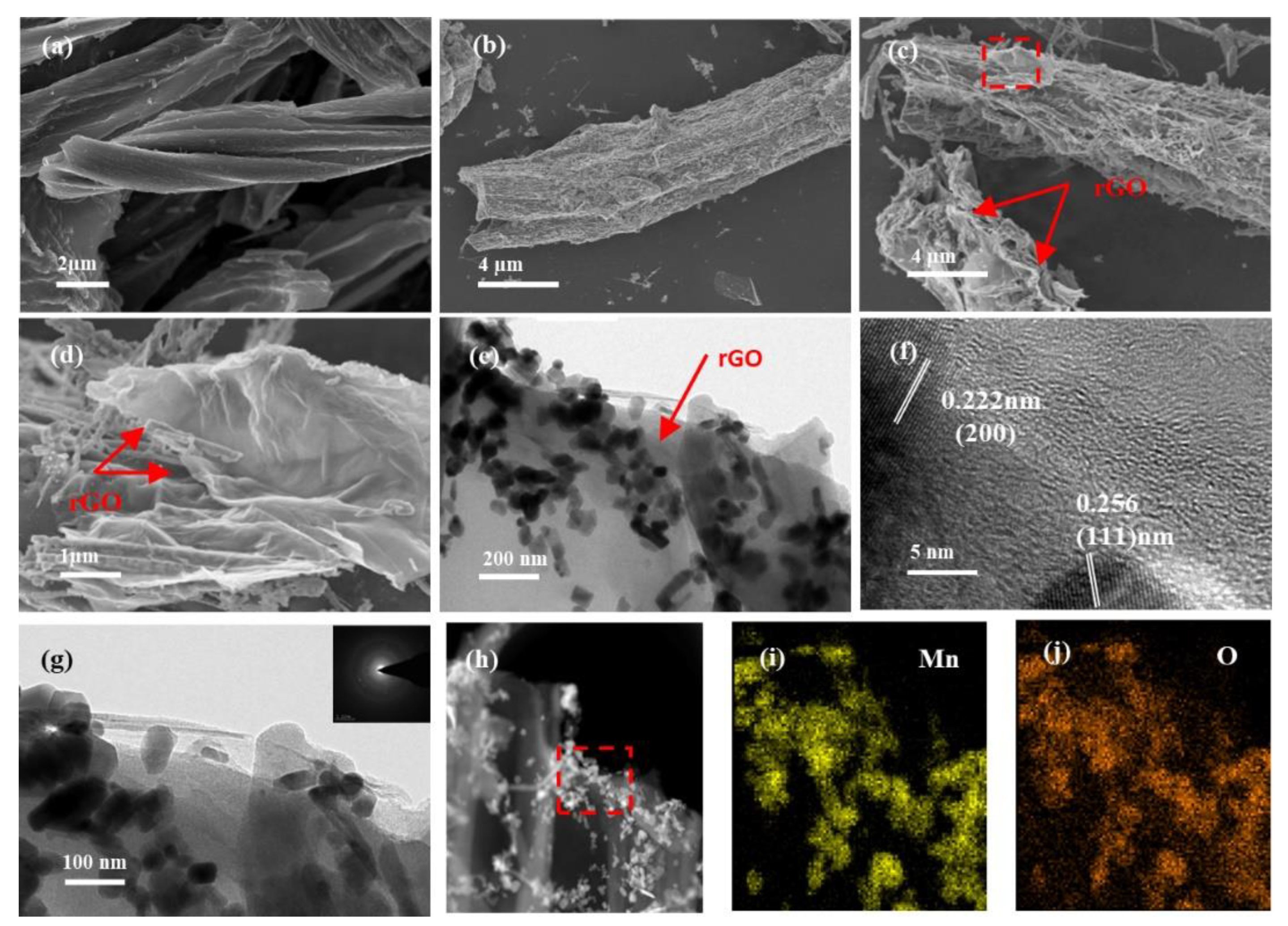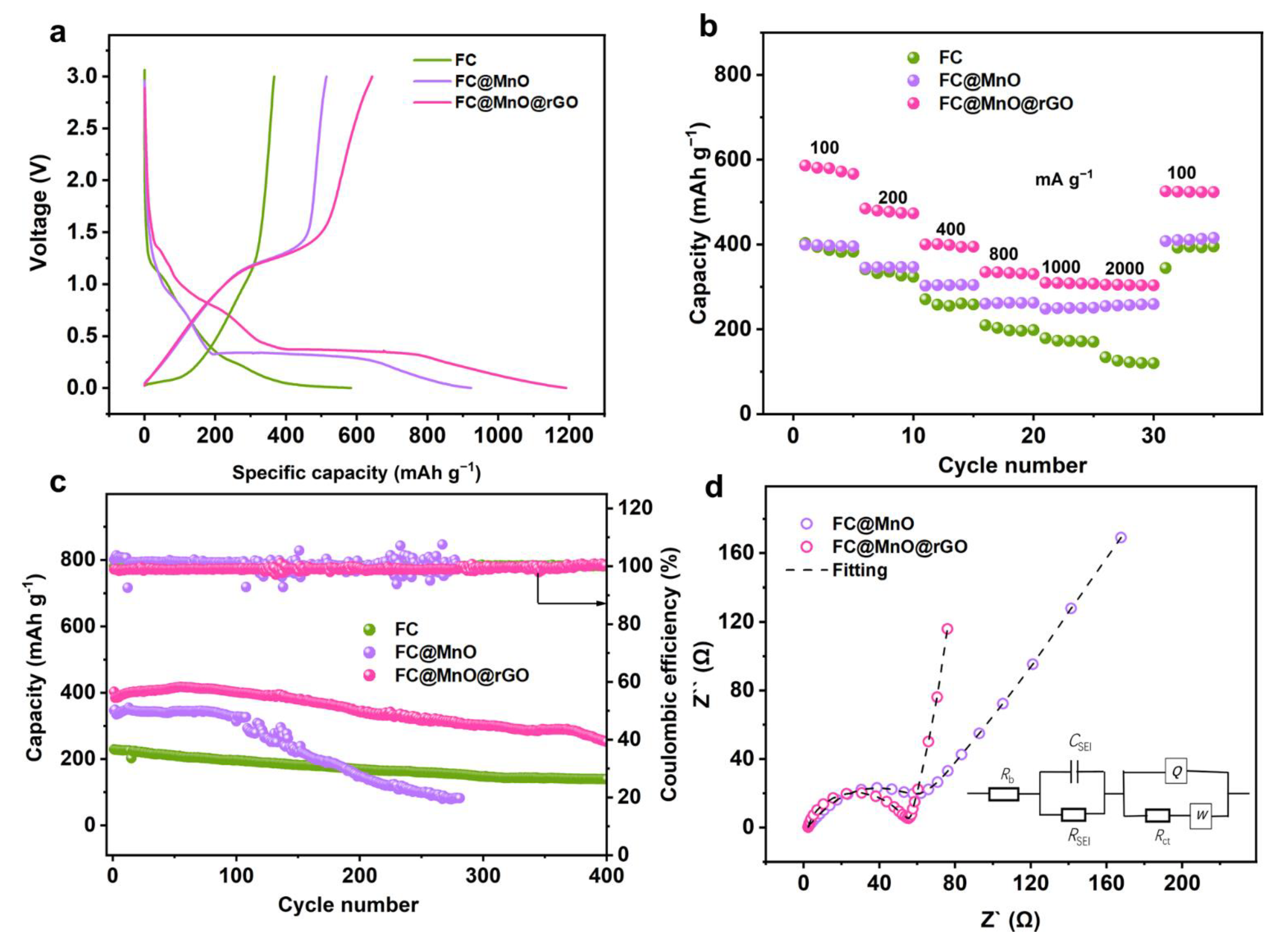Pine-Fiber-Derived Carbon@MnO@rGO as Advanced Anodes for Improving Lithium Storage Properties
Abstract
:1. Introduction
2. Materials and Methods
2.1. Synthesis of FC@MnO@rGO
2.2. Characterizations
2.3. Electrochemical Test
3. Results
3.1. Structure Parameters of FC, FC@MnO and FC@MnO@rGO
3.2. Elementary Analysis of FC@MnO and FC@MnO@rGO
3.3. Electrochemical Performance of FC, FC@MnO and FC@MnO@rGO
4. Conclusions
Supplementary Materials
Author Contributions
Funding
Institutional Review Board Statement
Informed Consent Statement
Data Availability Statement
Conflicts of Interest
References
- Duffner, F.; Kronemeyer, N.; Tübke, J.; Leker, J.; Winter, M.; Schmuch, R. Post-lithium-ion battery cell production and its compatibility with lithium-ion cell production infrastructure. Nat. Energy 2021, 6, 123–134. [Google Scholar] [CrossRef]
- Masias, A.; Marcicki, J.; Paxton, W.A. Opportunities and Challenges of Lithium Ion Batteries in Automotive Applications. ACS Energy Lett. 2021, 6, 621–630. [Google Scholar] [CrossRef]
- Cao, Y.; Xiao, L.; Ai, X.; Yang, H. Surface-modified graphite as an improved intercalating anode for lithium-ion batteries. Electrochem. Solid-State Lett. 2003, 6, 30–33. [Google Scholar] [CrossRef]
- Kim, H.-J.; Krishna, T.; Zeb, K.; Rajangam, V.; Gopi, C.V.V.M.; Sambasivam, S.; Raghavendra, K.V.G.; Obaidat, I.M. A Comprehensive Review of Li-Ion Battery Materials and Their Recycling Techniques. Electronics 2020, 9, 1161. [Google Scholar] [CrossRef]
- Xu, L.; Li, J.; Li, L.; Luo, Z.; Xiang, Y.; Deng, W.; Zou, G.; Hou, H.; Ji, X. Carbon dots evoked Li ion dynamics for solid state battery. Small 2021, 17, 2102978. [Google Scholar] [CrossRef] [PubMed]
- Lotfabad, E.M.; Ding, J.; Cui, K.; Kohandehghan, A.; Kalisvaart, W.P.; Hazelton, M.; Mitlin, D. High-density sodium and lithium ion battery anodes from banana peels. ACS Nano 2014, 8, 7115–7129. [Google Scholar] [CrossRef]
- Kalyani, P.; Anitha, A. Biomass carbon & its prospects in electrochemical energy systems. Int. J. Hydrogen Energy 2013, 38, 4034–4045. [Google Scholar]
- Gaddam, R.R.; Yang, D.; Narayan, R.; Raju, K.; Kumar, N.A.; Zhao, X.S. Biomass derived carbon nanoparticle as anodes for high performance sodium and lithium ion batteries. Nano Energy 2016, 26, 346–352. [Google Scholar] [CrossRef] [Green Version]
- Raghavendra, K.V.G.; Vinoth, R.; Zeb, K.; Muralee Gopi, C.V.V.; Sambasivam, S.; Kummara, M.R.; Obaidat, I.M.; Kim, H.J. An intuitive review of supercapacitors with recent progress and novel device applications. J. Energy Storage 2020, 31, 101652. [Google Scholar] [CrossRef]
- Zhang, X.; Hu, J.; Chen, X.; Zhang, M.; Huang, Q.; Du, X.; Liu, Y.; Li, X. Microtubular carbon fibers derived from bamboo and wood as sustainable anodes for lithium and sodium ion batteries. J. Porous Mater. 2019, 26, 1821–1830. [Google Scholar] [CrossRef]
- Jiang, H.; Hu, Y.; Guo, S.; Yan, C.; Lee, P.S.; Li, C. Rational design of MnO/carbon nanopeapods with internal void space for high-rate and long-life li-ion batteries. ACS Nano 2014, 8, 6038–6046. [Google Scholar] [CrossRef] [PubMed]
- Guo, J.; Liu, Q.; Wang, C.; Zachariah, M.R. Interdispersed Amorphous MnOx-Carbon Nanocomposites with Superior Electrochemical Performance as Lithium-Storage Material. Adv. Funct. Mater. 2012, 22, 803–811. [Google Scholar] [CrossRef]
- Xia, Y.; Xiao, Z.; Dou, X.; Huang, H.; Lu, X.; Yan, R.; Gan, Y.; Zhu, W.; Tu, J.; Zhang, W.; et al. Green and facile fabrication of hollow porous MnO/C microspheres from microalgaes for lithium-ion batteries. ACS Nano 2013, 7, 7083–7092. [Google Scholar] [CrossRef] [PubMed]
- Sun, Y.; Hu, X.; Luo, W.; Xia, F.; Huang, Y. Reconstruction of conformal nanoscale MnO on graphene as a high-capacity and long-life anode material for lithium ion batteries. Adv. Funct. Mater. 2013, 23, 2436–2444. [Google Scholar] [CrossRef]
- Liu, Y.; Zhao, X.; Li, F.; Xia, D. Facile synthesis of MnO/C anode materials for lithium-ion batteries. Electrochim. Acta 2011, 56, 6448–6452. [Google Scholar] [CrossRef]
- Su, L.; Zhong, Y.; Wei, J.; Zhou, Z. Preparation and electrochemical Li storage performance of MnO@C nanorods consisting of ultra small MnO nanocrystals. RSC Adv. 2013, 3, 9035–9041. [Google Scholar] [CrossRef]
- Zhang, W.; Sheng, J.; Zhang, J.; He, T.; Hu, L.; Wang, R.; Mai, L.; Mu, S. Hierarchical three-dimensional MnO nanorods/carbon anodes for ultralong-life lithium-ion batteries. J. Mater. Chem. A 2016, 4, 16936–16945. [Google Scholar] [CrossRef]
- Knápek, A.; Sobola, D.; Burda, D.; Daňhel, A.; Mousa, M.; Kolařík, V. Polymer graphite pencil lead as a cheap alternative for classic conductive SPM probes. Nanomaterials 2019, 9, 1756. [Google Scholar] [CrossRef] [Green Version]
- Li, J.; Chen, C.; Chen, Y.; Li, Z.; Xie, W.; Zhang, X.; Shao, M.; Wei, M. Polysulfide confinement and highly efficient conversion on hierarchical mesoporous carbon nanosheets for Li–S batteries. Adv. Energy Mater. 2019, 9, 1901935. [Google Scholar] [CrossRef]
- Li, H.; Jiang, L.; Feng, Q.; Huang, Z.; Zhou, H.; Gong, Y.; Hou, Z.; Yang, W.; Fu, C.; Kuang, Y. Ultra-fast transfer and high storage of Li+/Na+ in MnO quantum dots@carbon hetero-nanotubes: Appropriate quantum dots to improve the rate. Energy Storage Mater. 2019, 17, 157–166. [Google Scholar] [CrossRef]
- Im, J.S.; Park, S.J.; Lee, Y.S. Preparation and characteristics of electrospun activated carbon materials having meso- and macropores. J. Colloid Interface Sci. 2007, 314, 32–37. [Google Scholar] [CrossRef] [PubMed]
- Yang, C.; Gao, Q.; Tian, W.; Tan, Y.; Zhang, T.; Yang, K.; Zhu, L. Superlow load of nanosized MnO on a porous carbon matrix from wood fibre with superior lithium ion storage performance. J. Mater. Chem. A 2014, 2, 19975–19982. [Google Scholar] [CrossRef]
- Zhu, G.; Wang, L.; Lin, H.; Ma, L.; Zhao, P.; Hu, Y.; Chen, T.; Chen, R.; Wang, Y.; Tie, Z.; et al. Walnut-Like Multicore-Shell MnO Encapsulated Nitrogen-Rich Carbon Nanocapsules as Anode Material for Long-Cycling and Soft-Packed Lithium-Ion Batteries. Adv. Funct. Mater. 2018, 28, 1800003. [Google Scholar] [CrossRef]
- Yuan, T.; Jiang, Y.; Sun, W.; Xiang, B.; Li, Y.; Yan, M.; Xu, B.; Dou, S. Ever-Increasing Pseudocapacitance in RGO-MnO-RGO Sandwich Nanostructures for Ultrahigh-Rate Lithium Storage. Adv. Funct. Mater. 2016, 26, 2198–2206. [Google Scholar] [CrossRef]
- Lin, J.; Zeng, C.; Lin, X.; Xu, C.; Xu, X.; Luo, Y. Metal–Organic Framework-Derived Hierarchical MnO/Co with Oxygen Vacancies toward Elevated-Temperature Li-Ion Battery. ACS Nano 2021, 15, 4594–4607. [Google Scholar] [CrossRef] [PubMed]
- Zheng, F.; Yin, Z.; Xia, H.; Bai, G.; Zhang, Y. Porous MnO@C nanocomposite derived from metal-organic frameworks as anode materials for long-life lithium-ion batteries. Chem. Eng. J. 2017, 327, 474–480. [Google Scholar] [CrossRef]
- Zhang, Y.; Li, Q.; Liu, J.; You, W.; Fang, F.; Wang, M.; Che, R. Hierarchical Fe2O3@C@MnO2@C Multishell Nanocomposites for High Performance Lithium Ion Batteries and Catalysts. Langmuir 2018, 34, 5225–5233. [Google Scholar] [CrossRef]
- Shi, C.; Xiang, K.; Zhu, Y.; Chen, X.; Zhou, W.; Chen, H. Preparation and electrochemical properties of nanocable-like Nb2O5/surface-modified carbon nanotubes composites for anode materials in lithium ion batteries. Electrochim. Acta 2017, 246, 1088–1096. [Google Scholar] [CrossRef]
- Tian, X.-M.; Zhao, D.-L.; Meng, W.-J.; Han, X.-Y.; Yang, H.-X.; Duan, Y.-J.; Zhao, M. Highly porous MnO/C@rGO nanocomposite derived from Mn-BDC@rGO as high-performance anode material for lithium ion batteries. J. Alloys Compd. 2019, 792, 487–495. [Google Scholar] [CrossRef]
- Qiu, X.; Hua, Q.; Zheng, L.; Dai, Z. Study of the discharge/charge process of lithium–sulfur batteries by electrochemical impedance spectroscopy. RSC Adv. 2020, 10, 5283–5293. [Google Scholar] [CrossRef]
- Lin, C.; Hu, L.; Cheng, C.; Sun, K.; Guo, X.; Shao, Q.; Li, J.; Wang, N.; Guo, Z. Nano-TiNb2O7/carbon nanotubes composite anode for enhanced lithium-ion storage. Electrochim. Acta 2018, 260, 65–72. [Google Scholar] [CrossRef]
- Li, R.; Xiao, W.; Miao, C.; Fang, R.; Wang, Z.; Zhang, M. Sphere-like SnO2/TiO2 composites as high-performance anodes for lithium ion batteries. Ceram. Int. 2019, 45, 13530–13535. [Google Scholar] [CrossRef]
- Huang, Z.; Luo, P.; Zheng, H.; Lyu, Z. Sulfur-doped graphene promoted Li4Ti5O12@C nanocrystals for lithium-ion batteries. J. Alloys Compd. 2022, 908, 164599. [Google Scholar] [CrossRef]
- Wang, D.; Zhou, C.; Cao, B.; Xu, Y.; Zhang, D.; Li, A.; Zhou, J.; Ma, Z.; Chen, X.; Song, H. One-step synthesis of spherical Si/C composites with onion-like buffer structure as high-performance anodes for lithium-ion batteries. Energy Storage Mater. 2020, 24, 312–318. [Google Scholar] [CrossRef]
- Wang, X.; Qiu, S.; Lu, G.; He, C.; Liu, J.; Luan, L.; Liu, W. Fabrication of porous MnO microspheres with carbon coating for lithium ion battery application. CrystEngComm 2014, 16, 1802–1809. [Google Scholar] [CrossRef]




Publisher’s Note: MDPI stays neutral with regard to jurisdictional claims in published maps and institutional affiliations. |
© 2022 by the authors. Licensee MDPI, Basel, Switzerland. This article is an open access article distributed under the terms and conditions of the Creative Commons Attribution (CC BY) license (https://creativecommons.org/licenses/by/4.0/).
Share and Cite
Huang, Q.; Feng, B.; Deng, W.; Zhang, X.; Liu, G.; Su, G.; Chang, S.; Hu, J.; Liu, Y.; Xiao, G. Pine-Fiber-Derived Carbon@MnO@rGO as Advanced Anodes for Improving Lithium Storage Properties. Coatings 2022, 12, 1139. https://doi.org/10.3390/coatings12081139
Huang Q, Feng B, Deng W, Zhang X, Liu G, Su G, Chang S, Hu J, Liu Y, Xiao G. Pine-Fiber-Derived Carbon@MnO@rGO as Advanced Anodes for Improving Lithium Storage Properties. Coatings. 2022; 12(8):1139. https://doi.org/10.3390/coatings12081139
Chicago/Turabian StyleHuang, Qinyuan, Bing Feng, Wentao Deng, Xiang Zhang, Gonggang Liu, Geng Su, Shanshan Chang, Jinbo Hu, Yuan Liu, and Gang Xiao. 2022. "Pine-Fiber-Derived Carbon@MnO@rGO as Advanced Anodes for Improving Lithium Storage Properties" Coatings 12, no. 8: 1139. https://doi.org/10.3390/coatings12081139
APA StyleHuang, Q., Feng, B., Deng, W., Zhang, X., Liu, G., Su, G., Chang, S., Hu, J., Liu, Y., & Xiao, G. (2022). Pine-Fiber-Derived Carbon@MnO@rGO as Advanced Anodes for Improving Lithium Storage Properties. Coatings, 12(8), 1139. https://doi.org/10.3390/coatings12081139






